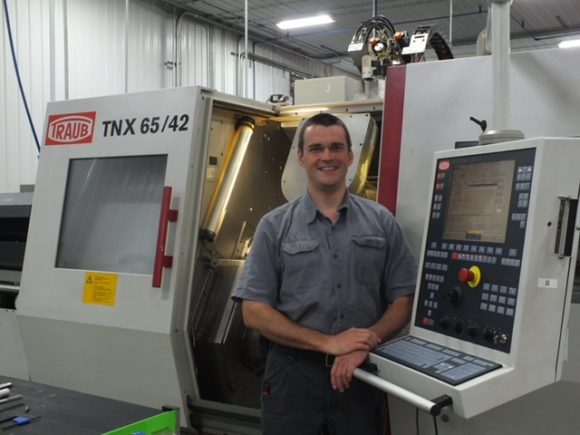For the third episode of our season about how machining companies acquire new work, I interviewed Jay Sauder, owner of Sauder Machine in Plymouth, Ohio. Sauder makes a variety of precision components such as casings for mechanical pocket watches and wheel cylinders for horse drawn buggies driven by Amish people.
Sauder Machine has no sales team nor a social media presence, yet it has a diversified, profitable customer base that continues to grow through great networking. Jay Sauder told me about how doing great work and establishing great relationships with customers has been the fuel to keep his business rapidly growing year after year.
Scroll down to read more and listen to the podcast, or listen with Google Podcasts, Apple Podcasts or your favorite app.

Main Points
Jay talks about the origin of Sauder Machine. His dad started the business with his uncle in 1982 in Lancaster, Pennsylvania. Jay is the fourth generation of machine shop owners in his family. In 2009 he started at the business and eventually took over administrative duties from his dad, who prefers to be working on machines to pushing pencils. Jay says when he started, the business had a lot of good customers, but his dad had not been charging some of them enough for various jobs to be profitable. (3:00)
Jay talks about his Mennonite background and how that has brought him Amish clientele. He grew up as Old Order Mennonite, a religious group with many common customs and origins as the Amish. He started driving a horse and buggy when he was 15 years old (he has only been driving a car for six years). Jay says the communities vary, but on the whole, Amish people are more conservative than Mennonites. Jay says he grew up with electricity and telephones in his house, while Amish people usually don’t have those amenities. Mennonites don’t have to have beards and don’t have to dress quite as conservatively as Amish. (5:00)
Jay says the commonalities and connections between Mennonite and Amish communities have brought Sauder Machine some important customers. Sauder Machine designed a hydraulic brake system for Amish and Mennonite carriages. The carriages already had brakes, but they were using cast iron rear cylinders imported from China, which were modeled after those on a 1941 light-duty Ford truck. Sauder’s wheel cylinders are made of anodized aluminum and are water resistant. The company also makes master cylinders. Since Sauder started making the wheel cylinders in 2012, it has produced 140,000 of them, which the company makes on an OKK CNC 500mm pallet horizontal mill. (7:45)
Jay says his company uses no advertising, sales team, manufacturer’s rep, or social media. The company has a single page website that Jay says has brought him a few RFQs in the past. He says his business connections and customer good will are his key getting new business. (10:20)
 Jay talks about a casing for a mechanical pocket watch he produces. Amish people do not wear wrist watches, and some require the watches to be mechanical rather than battery operated. An Amish watch producer in Wisconsin had been been importing his casings from China, but he was looking for a supplier in the United States. He spoke with an Amish owned machine shop in Ohio that Sauder made parts for, and they referred him to Sauder. Sauder sent him a quote and the watchmaker immediately ordered 5,000 pieces, which Jay says he will make on the company’s INDEX C65 lathe. (11:00)
Jay talks about a casing for a mechanical pocket watch he produces. Amish people do not wear wrist watches, and some require the watches to be mechanical rather than battery operated. An Amish watch producer in Wisconsin had been been importing his casings from China, but he was looking for a supplier in the United States. He spoke with an Amish owned machine shop in Ohio that Sauder made parts for, and they referred him to Sauder. Sauder sent him a quote and the watchmaker immediately ordered 5,000 pieces, which Jay says he will make on the company’s INDEX C65 lathe. (11:00)
Jay talks about a 2% discount he gives every customer if they pay within 10 days. He says 90% of his customers take this discount, everyone from the Amish watchmaker, to steel producers and Parker Hannifin. (15:00)
Jay says the same principles that have grown his business within the Amish community have helped him in other spheres. He says that a steel company customer in Ohio refers new clients to Sauder Machine. Jay says he keeps the steel company as a middleman, rather than working with those new clients directly. This reinforces their cooperative relationship. (16:00)
Noah asks Jay, what advice he would give a new company who does not have an existing network of customers to bring it referrals. Jay admits that he does not have experience in this scenario, but he suggests to try a service like manufacturing.com to source work, which hopefully would start a network of more customers. (18:30)
Jay says since he took over the business operations of Sauder, he has had to go to longtime customers and dramatically raise prices because the company was losing money on various jobs. He says some of the customers left, but within a year they came back and didn’t even try to negotiate. He says if you do parts right the first time, customers are not going to want to go elseware. (20:30)
Jay talks about the negotiation process with customers. Noah asks him what he would do in a hypothetical scenario where customer came to him with target a price of $2.00 per part, while he knew that Sauder could actually produce the part for $1.00. Jay says his first instinct is to offer to make the part for $1.75. This way Sauder makes some decent money, and the customer feels good as well. He says however, that if later he is able to improve his process internally to make the part cheaper, the price of the part to the customer will often stay the same. Sometimes he might lower the price to strengthen a relationship with a customer or stave off competition. (24:20)
Jay talks about his constant reinvestment in his business. He always is concerned with upgrading equipment and taking care of employees. He says taking the right steps to do good work is one of the most important ways to keep customers and find new ones. If people know they can buy parts from his company and there won’t be problems they will continue to come back and bring him new customers. (27:20)
Jay says he likes to buy equipment (always used) if he sees fantastic opportunities—he does not need to have work for it yet. He says the most money he has ever paid for a machine was $140,000 for a Traub he recently bought, which might have cost 6 or 7 times that price new. He says he is considering buying his first new machine, a Mazak Multiplex, for a Parker Hannifin job. To make a part come of the machine complete he needs a machining center that can do probing, induction hardening, and grinding. He says he is not afraid about losing the job because he could repurpose the machine. He also says that large companies often make decisions slowly. He says a part Sauder makes for Parker took two years from the time it made a sample part until being approved for production. Then it took another year to make one change on a print. (29:40)
Noah asks Jay to tell him something he learned last week. Jay says he learned he can draw out a solid piece of steel rod cheaper than the price of tubing by using an Iscar SUMOCHAM drill. He says the material cost is about $.60 cheaper. Jay says his philosophy is “live and learn, crash and burn. If the tool doesn’t crash you’re not pushing it hard enough.” (32:45)
Question: Is word of mouth the best way to find new work?
Podcast: Play in new window | Download

